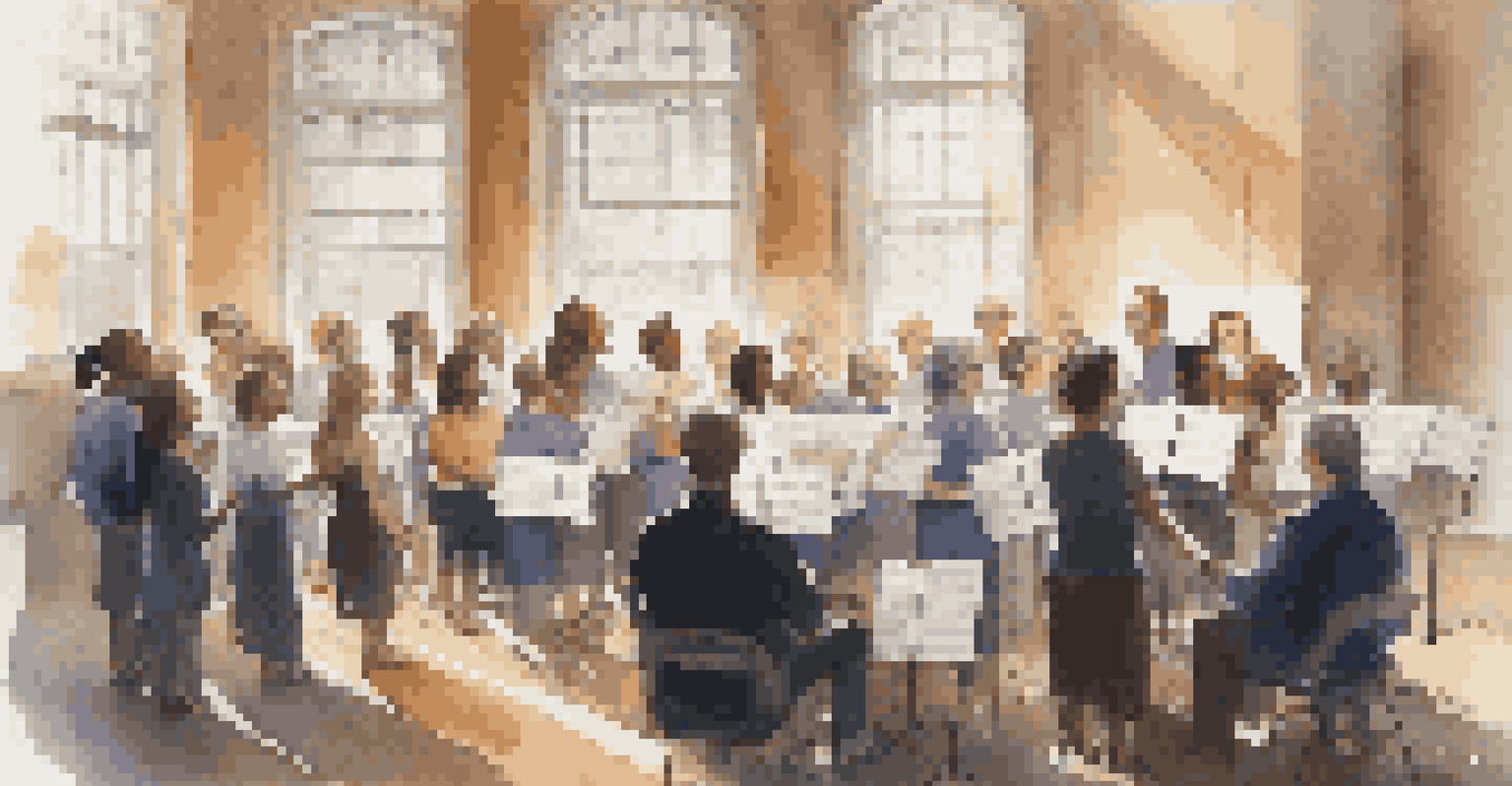Choral Music and Its Influence on Popular Culture

The Roots of Choral Music in Historical Context
Choral music has deep historical roots that stretch back centuries, often intertwined with religious practices. It began as a way to enhance worship, with groups of singers harmonizing to elevate the spiritual experience. Over time, these communal singing traditions evolved, influencing various musical forms and genres.
Music is the shorthand of emotion.
In the medieval period, choral music became integral to church services, laying the foundation for what we recognize today. Composers like Palestrina and Bach crafted intricate choral works that not only defined classical music but also inspired future generations. The impact of these early choral traditions is still felt in modern popular music.
As societies changed and musical tastes evolved, choral music adapted, blending with folk traditions and popular styles. This adaptability allowed it to remain relevant, contributing to the rich tapestry of global music culture. Today, we can see the echoes of these historical roots in contemporary choral arrangements across various genres.
Choral Music's Role in Film and Television
Choral music has a unique ability to evoke emotions, making it a popular choice in film and television soundtracks. From epic fantasy films to heartfelt dramas, choirs add depth and resonance that elevate the storytelling experience. Think of powerful moments in movies like 'The Lord of the Rings' where choral pieces enhance the narrative's emotional weight.

Television shows also utilize choral music to create memorable moments, often using it to underscore pivotal scenes. Series like 'Glee' have popularized choral arrangements of pop songs, bringing this art form to younger audiences. These adaptations showcase how traditional choral music can blend seamlessly with contemporary styles.
Choral Music's Historical Roots
Choral music has evolved over centuries, originating from religious practices and influencing various musical genres.
Moreover, the use of choral music in commercials has become increasingly common, tapping into its emotional power to connect with viewers. Brands leverage the uplifting and stirring nature of choir music to leave a lasting impression, demonstrating its versatility and appeal in popular culture.
Choral Music's Influence on Contemporary Genres
It's fascinating to see how choral music has influenced contemporary genres, particularly pop and rock. Artists like Florence + The Machine and Coldplay incorporate choral elements into their songs, enriching the sound with harmonies that resonate deeply with listeners. This blending of genres showcases the enduring appeal of choral music.
Choral music is a way to sing together, to make music in community, and to inspire each other to greatness.
In hip-hop, choral samples have emerged as a powerful tool for adding emotional depth. Tracks that feature choral backing vocals can transform a song, creating a dynamic contrast between the rhythm and melody. This cross-genre innovation highlights how choral influences can enhance storytelling in modern music.
Additionally, choral collaborations have become a trend, with musicians from various backgrounds coming together to create unique sounds. These partnerships not only celebrate the beauty of choral music but also bridge cultural divides, proving that music is a universal language. As choral music continues to evolve, its impact on contemporary genres remains significant.
The Rise of Pop Choral Groups
In recent years, pop choral groups have surged in popularity, blending traditional choral techniques with modern pop music. Groups like Pentatonix and The King's Singers have captivated audiences with their innovative arrangements and vocal prowess. They demonstrate that choral music can thrive outside of its classical roots.
These groups often perform a mix of original compositions and popular covers, showcasing the versatility of choral music. By reimagining well-known hits, they attract diverse audiences, including younger generations who might not have engaged with traditional choral music otherwise. Their success illustrates the adaptability of the choral form in today’s music landscape.
Choral Music in Modern Media
Today, choral music enhances film, television, and commercials, using its emotional power to connect with audiences.
Moreover, the rise of social media has allowed these groups to reach a global audience, sharing their unique sound far and wide. Platforms like YouTube and TikTok have enabled them to showcase their talent and creativity, further popularizing choral music. This accessibility has encouraged more people to explore and appreciate choral traditions.
Choral Music in Social Movements
Choral music has long been a powerful vehicle for social change, uniting voices for a common cause. Throughout history, choirs have lent their voices to movements advocating for civil rights, peace, and justice. Songs like 'We Shall Overcome' became anthems of solidarity, illustrating the profound impact of choral music on social movements.
In contemporary society, choirs continue to play a significant role in raising awareness about various issues. Community choirs often participate in events that promote social justice, using their music to inspire action and bring people together. This sense of unity is a testament to the enduring power of collective singing.
Moreover, virtual choirs have emerged, especially during challenging times like the pandemic. These online collaborations have allowed singers from all over the world to come together, fostering a sense of community and solidarity. It highlights how choral music can adapt and thrive even in difficult circumstances, proving its resilience and relevance.
Educational Impact of Choral Music
Choral music plays a vital role in music education, offering students the opportunity to develop their vocal skills and musical understanding. Participating in a choir helps individuals learn about harmony, rhythm, and teamwork. This foundation can lead to a lifelong appreciation of music, whether in performance or as an audience member.
Furthermore, studies have shown that singing in a choir can have positive effects on mental health and social skills. It fosters a sense of belonging and encourages collaboration, essential traits for personal development. Many school programs utilize choral music to enhance students' educational experiences, creating a nurturing environment for creativity.
Impact on Social Movements
Choral music serves as a unifying force in social movements, fostering solidarity and promoting social change through collective singing.
As students progress, they often find that choral experiences open doors to further musical opportunities. Many pursue careers in music, whether as performers, educators, or composers. This pathway showcases how choral music can inspire future generations, leaving a lasting legacy in the world of music.
The Future of Choral Music in Popular Culture
Looking ahead, the future of choral music in popular culture seems bright, with new trends and innovations on the horizon. As technology continues to evolve, we can expect to see more creative uses of choral music in various media. For instance, virtual reality experiences may integrate choral performances to create immersive environments that engage audiences in unique ways.
Additionally, as global connectivity increases, choral music may draw inspiration from diverse cultural backgrounds, leading to exciting new fusions. This cross-cultural exchange can enrich the choral tradition, making it more relevant to contemporary audiences. The blending of styles can result in fresh sounds that resonate with people from different walks of life.

Ultimately, the adaptability and emotional resonance of choral music will ensure its continued presence in popular culture. As artists and audiences alike embrace its transformative power, choral music will remain a vibrant part of the musical landscape, inspiring and connecting people for years to come.